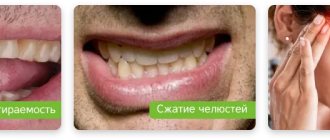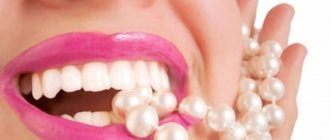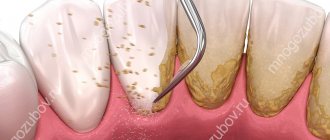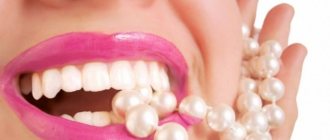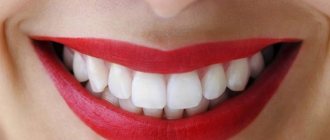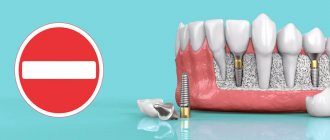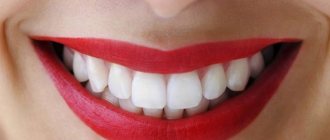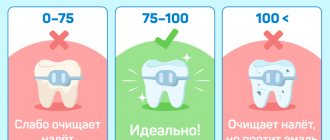02.02.2017
It often happens that if a child is weaned early or is being bottle-fed, the baby begins to suck his finger or requires a pacifier (pacifier). This happens because the sucking instinct inherent in nature is not fully satisfied, because bottle feeding occurs quite quickly. Scientists have proven that even while in the womb, a child can put a finger in his mouth and suck. Can you imagine how strong this instinct is if it manifests itself even before birth?
As a result, if the baby “doesn’t nurse”, it begins to cry long and drawn out - the parents calm it down with a pacifier. And when a pacifier is not given, the child himself finds a way out of the situation and uses his own finger to satisfy the instinctive need. Also, sucking on various objects can be used as a protective reflex in stressful situations.
However, no matter how harmless and cute your child may look, snoring with a fist at his mouth, this can lead to completely unexpected and very unpleasant consequences. Keep in mind that after seven months the sucking instinct in babies weakens, so if your child sucks a pacifier or finger, this is the time when you can painlessly begin to wean him off it.
The main problem when sucking a finger or pacifier (even anatomically correct one) is an incorrect bite. Either the lower jaw is strongly pushed back, or the front jaw protrudes strongly forward. It is also possible that the front teeth are crowded, they “crawl” over each other, and gaps may appear between the jaws. This is because the sucked finger creates abnormal excess pressure on the palate, teeth and jaw from the inside. Not only does the dentition change, but even facial features can become distorted over time.
Sexologist's opinion about oral sex
Professionals say that oral sex has a good effect on family life. A husband and wife who practice fellatio spend more free time together and do not avoid communicating with each other during the day.
In such families, according to sexologists, there are seven times less quarrels than in couples who do not accept oral sex. According to the observations of doctors, men in such couples do not experience problems with sleep, they fall asleep faster, they are not bothered by nightmares and insomnia.
And according to social surveys, husbands who receive oral sex often dream about their spouses. Whereas, on the contrary, in couples where blowjob is prohibited, husbands more often see unfamiliar or strange women in their dreams.
Don't be afraid of getting used to the pacifier
It is better to give your child a pacifier on time from infancy, then he is unlikely to put his finger in his mouth. A pacifier is contraindicated in the first month of life, when breastfeeding is becoming established, and then, up to 1.5 years, it will be a good helper. Children break up with pacifiers more easily and quickly than with the habit of thumb sucking.
Choose a pacifier according to age so that it is not too big for the child. Change it in time, because the rubber gradually becomes softer, and your baby's sucking muscles become stronger. For proper development, he must suck on the breast or pacifier with little effort. Not to mention that a child can bite off soft rubber.
Why give a blowjob, advantages:
- Safety. With such caresses there is no danger of getting pregnant. You can give pleasure to your partner without protection, without fear of consequences, even on the most “dangerous” days of the cycle.
- Rapidity. If a girl knows well how to give a blowjob, the process takes less than a minute. This can be useful when there is a risk of being seen or there are time constraints.
- Intimacy does not depend on environmental conditions. Sometimes the desire to have fun can come suddenly. If the conditions are unsuitable for sex, then it is more convenient to resort to oral sex. For example, at a party, on the street or in transport.
- Possibility of intimacy during menstruation. For a small part of women, menstruation lasts from a week to 10 days, this is their peculiarity. For young, temperamental men, this is a long period of abstinence; they can hardly stand even five days. At the same time, not all women agree to have sex during menstruation, just like not all men. Blowjob is a great solution in such situations.
Why thumb sucking is harmful
If a child regularly sucks his thumb, the main danger is improper bite formation.
“Thumb sucking at 2-3 years of age invariably affects the primary bite. In the anterior section, over time, the teeth stop closing, and we get a pathology such as an open bite. If you don’t fight a bad habit and don’t work with an orthodontist, the pathological condition persists in the permanent dentition,” warns pediatric dentist Tatyana Nikitina. According to her, other negative consequences are also possible: “Nature seeks to fill the empty space between the teeth, and the tongue is the easiest to do this. The tongue does not fit correctly, the child cannot produce some sounds correctly.” This is how a diagnosis of “parafunction of the tongue” is formed, speech production is impaired, breathing difficulties are possible, and, as a result, the appearance of dry mouth, which increases the risk of developing caries and inflammation on the mucous membrane. “From a dental point of view, thumb sucking at any age is a bad habit,” says Tatyana Nikitina. “A pacifier up to 1.5 years is normal, but later it is necessary to eliminate it.”
Pediatric dentist Marina Tkacheva adds that the nipple should be of the correct shape - with a beveled bottom. She also considers thumb sucking harmful, also for hygienic reasons, and advises against acquiring this habit during infancy, so that you do not have to struggle with it later.
What do men like during oral sex?
Blowjob is a pleasant caress, but there are some things that are especially pleasant for a man:
- The entire penis is not an erogenous zone. Its trunk itself is not as sensitive as the head, neck of the head and frenulum. There are also many nerve endings on the lower part of the trunk. The most pleasant caresses of these parts will be.
- Sometimes light touches of the teeth are very stimulating. This should be gentle touching, not biting. For the greatest effect, it is advisable to keep the same rhythm.
- Stimulating the penis and testicles with your mouth and hands at the same time enhances the sensations.
What to do if a 2 year old child sucks his thumb?
If your baby is already eating solids and is not breastfeeding but is still thumb sucking regularly, it could be due to stress, fear, irritation or boredom because sucking helps him relax. Sometimes this habit is acquired if a child experiences a divorce or quarrel between parents, entering kindergarten, moving, the arrival of a new family member, or some other major change. At such moments, the child will be helped by love, tenderness, affection, relaxing techniques such as massage or working with a child psychologist.
If a child lives without shocks, but still sucks his thumb, observe in what situations he does this. Candidate of Psychological Sciences Olga Egorova states: “If a parent notices that a child sucks his finger every time after some kind of stress - a sharp sound, a change in temperature, or if it’s time for the child to sleep and the parents do not put him to bed, or he has a fever, cutting teeth, tummy hurts - then this will be an indicator that this is how the child calms down, which means he is experiencing some discomfort.” Perhaps he is angry about something, or worried, or just bored. Give him more attention, entertain him, play together. A child may be bored if he lacks toys or the company of other children.
“If your child sucks his thumb too much, try to make his life more enjoyable for him,” writes American scientist, pediatrician and educator Benjamin Spock. - Remind him sometimes that someday he will grow big and stop sucking his thumb. Friendly encouragement will make him want to get rid of this habit as soon as he can. But don't be mad at him for it."
Remember that the habit of thumb sucking is only a sign that the child is missing something. This means that the best thing is to help him cope with the cause, and not just extinguish the effect.
Basic mistakes
Women learn how to give a blowjob from pornographic films, where the actions of actresses are aimed only at entertainment, and not at the pleasure of their partner. Now there are blowjob courses that teach you from scratch and help you avoid common mistakes.
- Influencing only the head is a big mistake, since this part can lose its sensitivity if overstimulated. We must not forget about other parts of the genitals. There are many nerve endings on the scrotum.
- You should not start and end oral sex abruptly. Men, like women, need time to tune in.
- You should not give a blowjob too intensely - the act will end quickly, but will not differ from regular masturbation. Speed makes the partner think that the girl wants to finish the caresses as quickly as possible; they are unpleasant for her.
- The monotony of movements leads to the fact that a man stops enjoying oral sex. Ejaculation occurs, but there is no moral satisfaction, and it plays an important role, as well as physiological. Therefore, it is better to change and add new movements and caresses.
- You need to give a blowjob without tension. Any sexual contact, except violence, is joy and relaxation. Strenuous activities cause discomfort.
- Don't hide your face during a blowjob. Inexperienced women think that they look stupid and ugly at such moments, but men perceive it differently. The partner's face during a blowjob excites them very much.
- Having oral sex without making any sounds is also wrong. When a girl shows with moans and sighs that oral sex brings her pleasure, then the excitement and pleasant sensations for her partner will be many times stronger.
- If a woman is not ready to swallow semen, you need to discuss this in advance, as well as other intimate details. At least on a like-dislike level.
Designed by nature
It all starts with the sucking instinct, which a newborn needs to survive. While still in the womb, the baby can suck his thumb, thus preparing for the breastfeeding that awaits him after birth. Proper sucking not only ensures the receipt of food, but also develops several systems in the body of a new person, forms the facial skeleton, and calms the child.
The sucking instinct, as a rule, fades away by 1.5-2 years of life. Until then, it is important for the child to satisfy his need for sucking, which is individual for everyone. If this does not happen, he may suck his finger, fingers, lips, or foreign objects, which becomes a bad habit.
Types of blowjob
According to the types of caresses, we can distinguish types of blowjob:
- Pure, in which only the lips and tongue are involved. The hands don't work in it at all. This is a good method for beginners. With this option you can learn basic movements. The main thing is to make sure not to injure the genitals with your teeth.
- Combined view. Here you need to give a blowjob not only with your lips, but also add caress with your hands. The penis is stimulated simultaneously with the mouth and hands or alternately. This method is good if the man’s genitals are large and the girl needs rest. Hand caress is much more active than stimulation with the mouth. At the same time, you can make movements with your hands so that they look visually beautiful.
- Throat option. It is one of the most difficult methods, but men unanimously claim that this is the best blowjob. It’s not called “royal” for nothing. With this option, the penis goes completely into the throat. The biggest difficulty is that touching the larynx causes a gag reflex. This reflex is difficult and often impossible to get rid of. But this can be achieved with training or a spray that freezes the larynx.
An artificial phallus is suitable as a simulator. It is fixed on the table, for which it is convenient to use the version with a suction cup, and then start training. To make the dive successful, do the exercise at a comfortable angle and pronounce a long “A” sound, which helps the larynx open. Such training is beneficial and over time the gag reflex disappears.
Breastfeeding and baby's dental health
The birth of a child is an important event in the life of every woman, and every mother wants her child to grow up healthy. Breastfeeding helps the child’s body grow and develop harmoniously as a whole, and also has a great influence on the formation of the maxillofacial skeleton, speech, and hearing. When breastfeeding and when bottle-feeding, the baby's bite will develop differently.
It has long been known that breast milk is the healthiest and most beneficial food for a child; it contains all the necessary minerals and trace elements that are necessary for the formation of teeth. But can milk destroy teeth? What does research say about this? Children who were breastfed for at least 12 months were 56% less likely to develop a malocclusion than children who were breastfed for less than that period [1]. The formation of a child’s teeth occurs during pregnancy: in the early stages, the crowns of baby teeth are formed, and in the seventh or eighth month, the first molars (permanent) are formed. The shape and color of teeth are genetically determined, but it is entirely within the mother’s power to make them healthy, and this concern for the health of the child’s teeth begins already from the period of breastfeeding [2]. Bad teeth in a child are not only unsightly, but also not healthy, painful and expensive, and it is also completely preventable!
The influence of breastfeeding on the development of occlusion.
The first milk teeth begin to erupt at 6-7 months - these are the lower incisors, and the last to erupt are the upper and lower chewing teeth, this happens by 20-30 months. This is the period of formation of a temporary occlusion, and it approximately corresponds to the physiological periods of breastfeeding, which is why the teeth began to be called milk teeth.
When a baby is born, his lower jaw lags in growth from the upper jaw, it seems to be shifted back relative to the upper jaw - this is necessary to protect it during childbirth, since it is the only movable bone on the human head and can be injured. But this relationship of the jaws is temporary, the child grows, matures, and the lower jaw must “catch up” with the upper, because in adults the jaws are developed evenly.
When a baby suckles, he actively works with his lower jaw and tongue; these movements are unique. The lower jaw lowers and moves forward, and the tongue makes wave-like movements during sucking, at this moment the muscles of the tongue, the floor of the oral cavity, and facial muscles are also involved. The most important point for the healthy development of the oral cavity is that while sucking at the breast, the child learns the physiologically correct movement of the tongue. [3]
The size and shape of the teeth are determined genetically, but the location where they will be and the size of the jaw depend on the child’s muscle activity during his growth period. That is, the jaws develop every day, and feeding is of great help. If the jaws are not developed, there will be little space for teeth. In the future, this guarantees their crowding.
What is the difference between sucking a pacifier and sucking a breast?
If during the neonatal period and the first 6 months of life the child sucks a pacifier rather than a breast, then the development of the dentofacial apparatus occurs differently. When sucking a nipple, you do not need to put in significant effort to get a portion of milk; facial muscles are not fully involved in the sucking process.
In addition, unlike breastfeeding on demand, the baby receives nutrition from the nipple by the hour, and this cannot satisfy his sucking reflex. Breast substitutes are used - fingers, pacifiers, corners of diapers, and even the tongue... The mechanism of sucking various objects leads to poor development of the circular muscles of the face, as well as to the habit of pushing the tongue out of the mouth, exerting harmful pressure of the tongue on the teeth. This, in turn, determines the development of various types of malocclusion. [4]
It is important to understand that any, even the most modern and physiological feeding bottle or pacifier is only an imitation of a breast, and the child’s body needs “real” sucking for proper development.
Does breast milk cause tooth decay?
Canadian dentist Dr. Brian Palmer says, “If breast milk caused tooth decay, it would be evolutionary suicide.”[2] After all, nature in our world never creates anything superfluous or unnecessary. Everything that is conceived has its own meaning. It would be extremely strange to create a factor without which, on the one hand, it would be impossible for the baby to survive, and on the other, which would undermine his health. [5, 6]
Modern studies have found that breast milk practically does not reduce the level of acidity in the mouth, while tooth decay occurs precisely in an acidic environment; The immunoglobulins IgA and IgG contained in milk can inhibit the growth of streptococcal bacteria, and lactoferrin, one of the most important protective proteins in breast milk, contributes to their death. In addition, breast milk remineralizes tooth enamel, that is, it “supplies” calcium and phosphorus to the teeth.
Saliva is also important. It maintains normal levels of acidity in the mouth and contains calcium and phosphorus, which are essential in the remineralization of teeth. At night, salivation decreases. If your baby nurses frequently at night, he will continue to produce enough saliva to prevent his mouth from drying out and keep his teeth healthy. Thus, breastfeeding reduces the risk of tooth decay. [7]
Another important point is the accumulation of fluid in the baby’s mouth. Breast milk sucked from the breast does not accumulate in the mouth, because The nipple is deep in the baby's mouth, and the milk goes behind the teeth, almost straight into the throat. When a child during mature lactation does not suckle the breast, but simply holds the nipple in his mouth, then milk does not enter his mouth at all. [8]
Sucking on a bottle occurs differently; the liquid comes into more contact with the teeth. In addition, even if the baby is not actively sucking, it may continue to leak into the mouth through the hole in the nipple, the teeth “bathing” in this liquid, which leads to an increase in the activity of bacteria that destroys teeth. The situation is aggravated by the fact that formula, juices, and compotes do not have the protective properties of breast milk, and if stored for a long time before use, they may themselves contain bacteria. Therefore, sucking a bottle can have an extremely negative effect on the health of a child’s teeth; there is even the concept of “bottle caries.”
It is worth noting that none of the studies conducted have proven a consistent or strong link between breastfeeding and the development of tooth decay. [9, 10] Regardless of the child’s age or dental health, breastfeeding helps teeth grow healthy, maintains the child’s immunity, and the constant composition of saliva, which washes the teeth and prevents bacteria from multiplying. Regardless of the type of feeding, prevention and timely treatment of caries is important: attention to the child’s oral hygiene, regular brushing of teeth, and visits to the dentist.
To summarize, it should be emphasized that breastfeeding allows you to take care of the baby’s health, providing him with the best nutrition and development, including the formation of a correct bite and healthy teeth.
Anna Kozhevina, dentist, lactation consultant
Literature:
- Fernanda Caramez da Silva, Elsa Regina Justo Giugliani, and Simone Capsi Pires. Breastfeeding Medicine. December 2012, 7(6): 464-468. doi:10.1089/bfm.2011.0123.
- Palmer, B. “Infant Dental Decay—Is it Related to Breastfeeding.” A Presentation, 2000.
- Torney, H. “Prolonged, On-Demand Breastfeeding and Dental Caries-An Investigation.” Dublin, Ireland, 1992.
- Obraztsov Yu. L., Larionov S. N. Propaedeutic orthodontics: a textbook. Russian Journal of Biomechanics, Vol. 7, No. 4: 9-21, 2003.
- Peres, KG, Cascaes, AM, Nascimento, GG and Victora, CG (2015), Effect of breastfeeding on malocclusions: a systematic review and meta-analysis. Acta Paediatr 104: 54–61. doi:10.1111/apa.13103
- Bonyata, K. Is Breastfeeding Linked to Tooth Decay? https://www.kellymom.com/bf/older-baby/tooth-decay.html
- Palmer, B. Breastfeeding and infant caries. ABM News and Views 2000 Dec; 6(4): 27-31.
- Sum, Fung Hou Kumoi Mineaki Howard et al. “Association of Breastfeeding and Three-Dimensional Dental Arch Relationships in Primary Dentition.” BMC Oral Health 15 (2015): 30. PMC. Web. 14 Nov. 2016.
- Slavkin, H. Streptococcus mutans: early childhood caries and new opportunities. JADA 1999; 130:1787-92.
- Weerheijm, KL Prolonged demand breastfeeding and nursing caries. Caries 1998, 32(1): 46-50.
Technicians
Skillful techniques can add variety to intimate life and bring many new sensations. To master them, you can watch a video tutorial or go to training. A few common techniques:
For newbies
Make an “O” with your lips and cover your teeth with them. Holding the penis, move it with wet lips. Having reached the limit of a comfortable state, linger for a couple of seconds and return back. Repeat the movements. You can add your tongue to the action by moving it along the shaft of the penis.
Eskimo
Very simple, easy technique. To give a blowjob, you need to pull the skin of the penis down, thereby freeing the head. And then imagine that it is ice cream and start licking it with your tongue. Any movements, the more interesting, the better. To add variety, you can try to write all the letters of the alphabet on the head. The main thing is that the tongue is wet and the teeth do not participate in the act.
Hickey
You need to imagine that your mouth is a vacuum cleaner, pull the penis into your mouth about halfway, and then try to pull it out without weakening the vacuum.
The speed is very different. Many people like it when such movements are made quickly. Language is not needed here and can only get in the way. It is very important not to damage the penis with your teeth while getting carried away.
Deep Throat
Or "Royal Blowjob". The very method that men love so much - the penis penetrates deep into the throat. This technique often causes gagging when performed. For such a blowjob, the larynx is opened and relaxed, then the penis easily slips inside.
There are special sprays that freeze the larynx, usually they contain lidocaine. By “freezing” her throat, a woman loses her gag reflex for a short amount of time. This technique can be learned by training on a dildo, but without freezing, not all women can cope with the gag reflex.
Crazy orgasm
For this trick, a finger is used to block the channel at the base of the penis through which sperm passes. At the same time, the mouth and hand continue to massage the penis along the entire length of the shaft. Clamping simulates the spasm that accompanies ejaculation. When the channel is released by releasing the finger, an orgasm occurs that is more intense and longer than usual.
Kitty
You need to sit comfortably between the man’s legs and start caressing his crotch with your tongue. From the anus and throughout the perineum, without forgetting even a single centimeter of the body. The movements are reminiscent of how cats lap up water with their tongues.
Wet
To perform it, you need to lubricate your hands with gel lubricant and do not swallow saliva. The penis will be very wet and the sliding will be intense. They take the head into the mouth, and then move away and let it pop out of the mouth with a popping sound.
Butterfly wings
Just below the head of the penis there is an area called the crown. Beneath it is a vertical fold of delicate skin. If you constantly stimulate this area during oral sex, you can greatly increase sensations.
Rotation
Wet lips are placed around the head and twisted along the line of the frenulum. This stimulation causes orgasm very quickly. It will help restore an erection if it has subsided.
Dental prosthetics without grinding, what is it?
Before analyzing the pros and cons of this procedure and types of prosthetics, you need to understand the definition itself. So, prosthetics without turning is one of the methods of prosthetics that do not destroy the tooth structure.
To install a crown, you must first suppress the caries so that it does not develop further. To do this, the canals are cleaned, the tooth is treated with a drill, thus preparing the cavity for further actions. When installing a bridge, healthy adjacent teeth are also affected. They also have to be depulped, that is, the nerves have to be removed.
During prosthetics, crowns are placed on healthy supporting teeth on both sides of the void in the gum. In order to install crowns and fix them, you need to grind down the healthy tooth covering. This is a big disadvantage of this procedure. It is unpleasant and, to some extent, offensive, because orthopedic dentists themselves grind down healthy, strong teeth.
To summarize, we can say that by treating one tooth, we kill the neighboring ones, bringing them closer to possible destruction, since they are considered dead. And they are destroyed due to the fact that they cease to participate in the exchange of useful substances and become more vulnerable. The situation is aggravated by the increased load due to the fact that they are a support for the prosthesis.
Despite these consequences, prosthetics using the methods described above are still used in dentistry, but the method without grinding is becoming increasingly popular.
